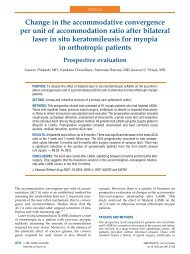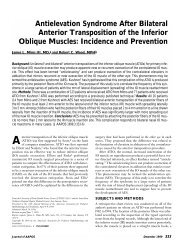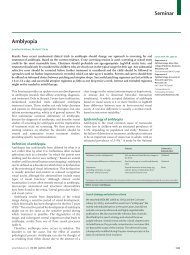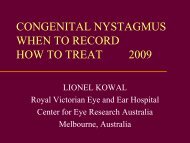What's new AAPOS 2008 - The Private Eye Clinic
What's new AAPOS 2008 - The Private Eye Clinic
What's new AAPOS 2008 - The Private Eye Clinic
Create successful ePaper yourself
Turn your PDF publications into a flip-book with our unique Google optimized e-Paper software.
Laryngeal and tracheal anomalies<br />
Positive family history<br />
Nasal anomalies<br />
Apical involvement with fibrous dysplasia: Implications for vision<br />
Cruz AA, Constanzi M, de Castro FA, dos Santos AC.<br />
Ophthal Plast Recontrs Surg 2007 Nov-Dec; 23(6):450-454.<br />
Patients with orbital Fibrous Dysplasia (FD) present with the classical signs of proptosis,<br />
dystopia and periorbital facial asymmetry. FD is a disorder of the adenyl cyclase<br />
system. This is a prospective case series of 21 patients with fibrous dysplasia with<br />
orbital involvement. Four of the patients had McCune Albright syndrome and 1 had<br />
Tuberous Sclerosis. Strabismus was not a frequent complication; 2/21(9.5%). Lacrimal<br />
duct obstruction was also infrequent; 1/21(4.76%) had epiphora. Of the 34 orbits<br />
affected, the roof was affected in 67.7%, whereas the floor was the least affected wall.<br />
Nineteen orbits showed radiologic signs of optic canal and/or superior orbital<br />
encasement. No patient showed any sign of trigeminal dysfunction or severe visual<br />
loss, despite long disease duration. <strong>The</strong> authors believe that patients with apical<br />
involvement should be carefully followed and have their apices decompressed only<br />
when their vision is clearly deteriorating. <strong>The</strong>ir data does not support prophylactic optic<br />
canal decompression as a therapeutic measure. <strong>The</strong> authors believe the presence of<br />
intralesional cysts near the apex is clearly an indication for surgery.<br />
Ocular Clusterin expression in von Hippel-Lindau disease<br />
Zhou M, Shen D, Head JE, Chew EY et al.<br />
Mol Vision 2007 Nov; 13:129-26.<br />
Retinal hemangioblastoma/hemangioma is the most frequent and often earliest clinical<br />
manifestation of VHL disease. Although retinal hemangioblastoma associated with VHL<br />
usually presents at a relatively young age (median 25 years), the cumulative probability<br />
increases each decade of life, reaching 80% by the eighth decade. <strong>The</strong> majority of<br />
initial retinal hemangioblastoma associated with VHL disease are located in peripheral<br />
retina, while per papillary lesions are only reported in 10% of cases. Complications<br />
from retinal hemangioblastomas, even in optimally treated cases are visually significant.<br />
<strong>The</strong> probability of visual loss is age dependent. <strong>The</strong> life time cumulative probability of<br />
permanent visual loss is 60, with most of the risk (43%) falling with within the first 30<br />
years of life.<br />
Clusterin (also termed apolipoprotein J) is a multifunctional glycoprotein. This is a<br />
retrospective case series investigating ocular clusterin expression in VHL in 9 eyes with<br />
retinal hemangioblastoma, one eye with VHL but without ocular disease, one surgically<br />
excised optic nerve with optic nerve hemangioblastoma, and 3 normal control eyes.<br />
Ocular specimen were evaluated by routine histology, immnohistochemistry for clusterin<br />
expression, and molecular detection of clusterin transcripts with ocular VHL<br />
hemangioblastomas compared with normal tissue from the same eye using<br />
microdissection and quantitative real time PCR. <strong>The</strong>re was marked decrease of<br />
clusterin immunoreactivity in all retinal hemangioblastoma and the optic nerve<br />
hemangioblastoma , whereas positive clusterin reactivity of the vascular and glial<br />
components were similar to that of normal retina. PCR confirmed the decrease of<br />
67
















